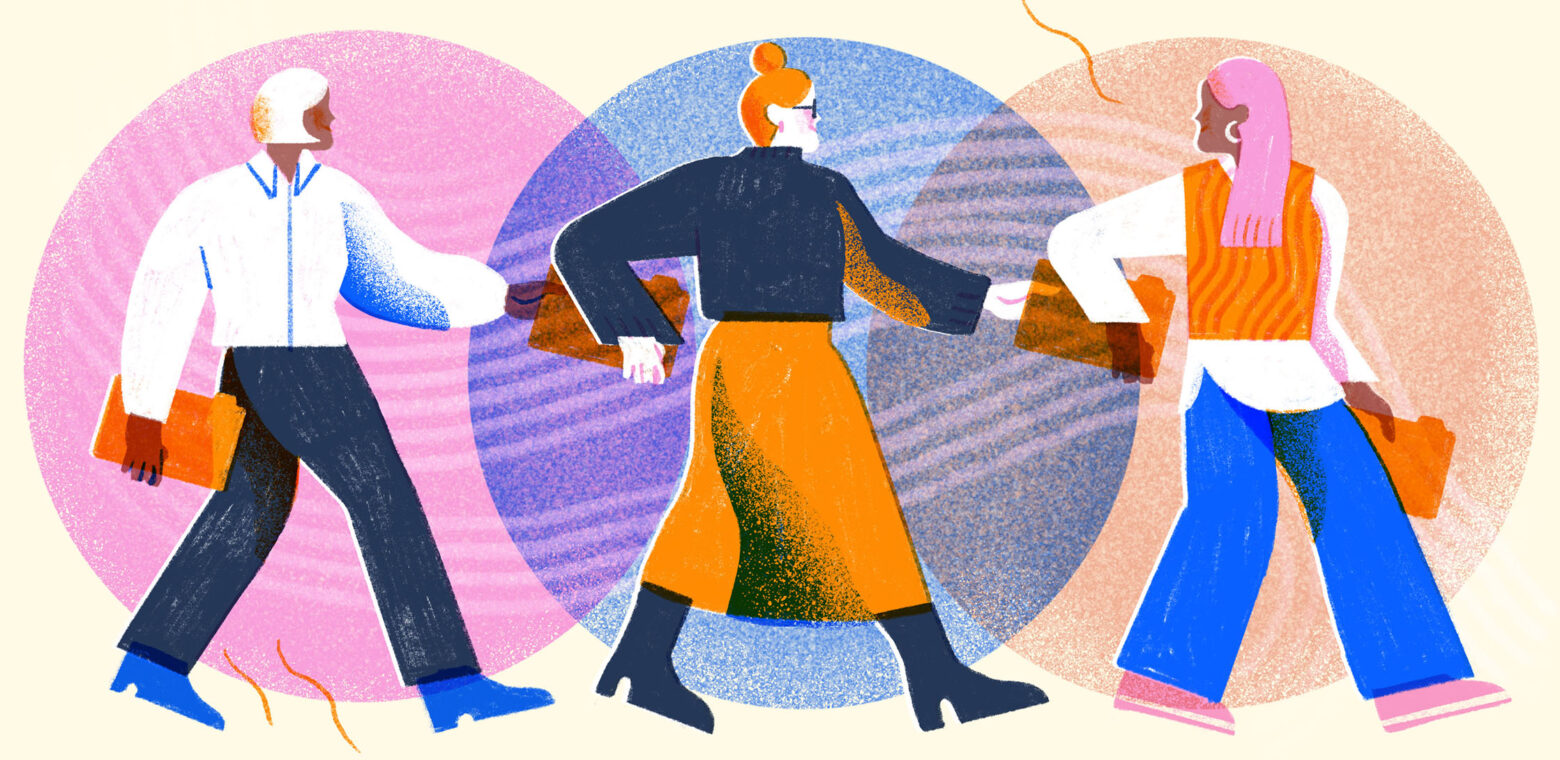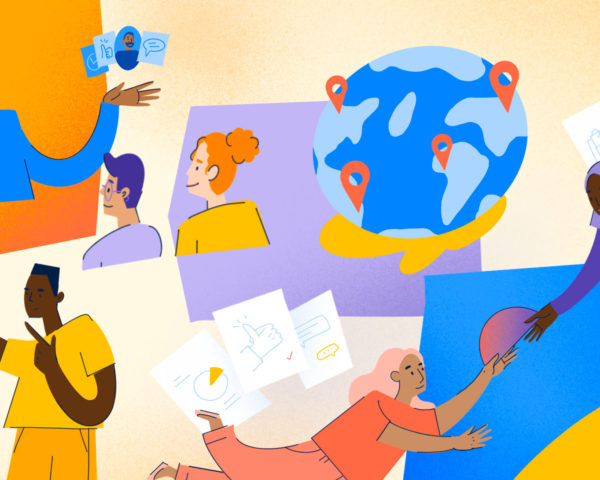How generational differences in the workplace shape better, more productive teams
Building multi-age teams that embrace generational differences is key to unlocking the power of diversity at work.
5-second summary
- Age is often overlooked as an element of diversity, but research suggests teams with generational differences in the workplace are more productive.
- Multigenerational colleagues work better together when they understand what each generation is like and why. (Just watch out for falling into the trap of stereotypes and ageism.)
- Reaping the full benefits of diversity requires not just hiring people from underrepresented communities, but also building a culture that encourages learning from each person’s unique perspectives and experiences.
Recently, I took my five-year-old son to the park to get some energy out during the “unhappy hour” between dinner and bedtime. I learned more in 20 minutes about generational differences in the workplace than I had in my almost 20-year career.
My son approached a group of kids – some as young as toddlers, some as old as preteens – who were building a city out of sand, rocks, twigs, and other knick knacks from around the park. Despite their vast age differences, they worked through the challenge as a team and brought out each other’s strengths.
The big kids took the lead and gave instructions to the littlest kids, who not only followed guidance, but also added new ideas like bringing back new materials they found for the city. The middle-aged kids, including my son, were the “sandwich generation” of the playground, focused on collaborating with the little ones on material sourcing and the older ones on construction techniques. There were laughs. There were arguments. There were proud moments at the end. It was truly a lesson in inter-age play and collaboration!
The same can – and should – happen in the workplace. We already know that diverse workplaces are better for a company’s employees and bottom line. (Research proves it.) But when we think of diversity, characteristics like race and gender are typically at the forefront. Age is often overlooked. However, just like I saw on the playground, generational diversity – coupled with a culture that encourages learning from each other – can bring out the best in each of us and our bodies of work.
Our histories shape us
There is evidence that mixed-age teams are more productive in the workplace than teams of the same age. And today, it’s theoretically easier than ever to build a multigenerational workforce because there are five generations working for the first time in U.S. history:
- Traditionalists: born in the 1920s – mid 1940s
- Baby Boomers: born in the mid 1940s – mid 1960s
- Generation X: born in the mid 1960s – 1980
- Millennials: born in the 1980s and 1990s
- Generation Z: born in the 2000s and 2010s
Exact years vary depending on the source, but regardless of the specific timeframes, each generation brings something unique to the table, shaped by collective experiences, outlooks, and characteristics. For example, many Traditionalists experienced the Great Depression and carried a frugal approach into everything they did long after the economy improved. Many Millennials came of age during the early 2000s and were significantly impacted by September 11th and the Great Recession, which influenced their views on the world and work.
Of course, every person is unique, and generational stereotypes can be wildly inaccurate (and unfair). In fact, these stereotypes often contribute to ageism of both younger and older workers. Ageism is obviously harmful to those who experience it, but the negative impacts extend to others too. Age discrimination (or any form of discrimination, for that matter) can contribute to a tense or even hostile work environment, which MIT research shows hinders productivity, engagement, and retention.While stereotyping by age can be counterproductive, each person’s beliefs and worldviews are often molded by the generation in which they grew up, and those perspectives do shape how they show up in the workplace. Just like other forms of diversity, when we understand and embrace our generational differences, we can become even better contributors, colleagues, and leaders.
Generational differences in the workplace
Whether you’re involved with hiring, managing, or simply collaborating with people of different generations, consider these guidelines as one way to understand how to work better together.
✹ Traditionalists ✹
Born: 1920s – mid 1940s
Workforce size: Smallest portion of the labor force (and shrinking)
Shaped by: World War II, economic downturns, launch of mass media
Common characteristics and values: Because many Traditionalists were impacted by war and economic strife during their formative years, they tend to value stability and be quite practical. Most workplaces followed traditional, hierarchical structures, which engrained the importance of seniority, respect, and rule-following into workers of this generation.
Preferred work communication: Since Traditionalists didn’t have access to what would be considered “modern” technology until later in life, they may prefer face-to-face conversations and handwritten notes.
Superpower: “[Older workers] are vital because they have a lot of experience. They’ve been contributing to the economy and to their own work. They’re living longer in good [health]. They have a great potential. And this notion that beyond a certain fixed age they are no longer productive, that they can no longer contribute to the society, is nonsense.” – Stefano Scarpetta
✹ Baby boomers ✹
Born: Mid 1940s – mid 1960s
Workforce size: A large, yet rapidly shrinking portion of the labor force
Shaped by: Vietnam and Cold Wars, civil rights movements, rise of pop culture
Common characteristics and values: As children of Traditionalists, many Baby Boomers developed a strong work ethic, along with a sense of responsibility and respect for their elders. However, because they experienced cultural and technological advancements while growing up, they tend to be more independent, confident, and forward-thinking in the workplace than their predecessors.
Preferred work communication: Since email wasn’t introduced until many Baby Boomers were midway or further through their career, the phone tends to be their preferred form of communication, especially for detailed conversations and relationship building. Email is also widely accepted, especially for transactions and simple requests.
Superpower: “Older people tend to be better at solving more complex, deep-rooted problems, because they often have a deeper level of understanding of current systems gained over the course of their careers. It’s when those very different ways of thinking come together, diversity of thought, that teams are able to reach their true potential.” – Aubrey Blanche
✹ Gen X ✹
Born: Mid 1960s – 1980
Workforce size: One of the dominant groups in the labor force (and shrinking)
Shaped by: Cold War, pop culture, technology, Y2K
Common characteristics and values: Raised amid the rise of mass media, technology, and political unrest in many regions, Gen X paved a more independent path than their traditional, rule-following predecessors. After seeing parents and grandparents work themselves to the bone, many Gen Xers started tipping the work-life scales to be more balanced and pushed their employers to focus more on people, not just on profits.
Preferred work communication: Email has been popular for most, if not all, of Gen Xers’ careers, so it continues to be the preferred form of work communication for many people in this generation.
Superpower: “While Gen X may be equally capable at digital tasks as millennials, they also show a mastery of conventional leadership skills more on par with leaders of the baby boomer generation. That includes identifying and developing new talent at their organizations and driving the execution of business strategies to bring new ideas to reality.” – Stephanie Neal and Richard Wellins
✹ Millennials ✹
Born: 1980s and 1990s
Workforce size: One of the dominant groups in the labor force (and growing)
Shaped by: Rise of the internet, domestic and international terrorism, global recessions
Common characteristics and values: Similar to Gen X, many Millennials see and respect the work ethic of previous generations, but want to invest more in their personal lives and in making the world around them better. Growing up with access to the internet made worldviews much more global, expectations for speed much higher, and hunger for improvement greater.
Preferred work communication: Speed and convenience are key for most Millennials. In addition to email, which was ubiquitous by the time they entered the workforce, many of them became proficient texters early in life and tend to prefer texting over phone calls.
Superpower: “In fact, more than 60% of millennials now have direct reports, giving them the opportunity to drive real change within their organizations and on the teams they lead…After decades of enduring company cultures that often seem stale or out of touch, the time has arrived for real change — a new evolution of culture that emphasizes trust, purpose, mission, and employee wellbeing.” – Ursula Kravlova
✹ Gen Z ✹
Born: 2000s and 2010s
Workforce size: A small, yet growing portion of the workforce
Shaped by: Global recessions, the rise of social media, COVID-19 pandemic
Common characteristics and values: Never remembering a time without the internet or technology, most Gen Zers are global-minded digital natives who value instant gratification and see speed as a requirement, not a luxury. Growing up amid difficult economic times made many Gen Zers more entrepreneurial, focused on personal fulfillment, and comfortable with change.
Preferred work communication: Gen Zers tend to prefer the forms of communication that will get them the fastest, easiest response: texting and instant messaging.
Superpower: “Subtly yet undeniably, as generational shifts tend to go, there’s a new crop of employees [Gen Z] determining the norms and styles of the workplace. And they have no qualms about questioning not just emoji use but all the antiquated ways of their slightly older managers, from their views on politics in the office to their very obsession with work.” – Emma Goldberg
Changing the culture, not just checking the box
While research suggests teams with generational differences are more productive, it takes more than inclusive hiring practices to reap the full benefits of diversity. Harvard Business School’s Robin J. Ely and David A. Thomas argue, “Increasing diversity does not, by itself, increase effectiveness; what matters is how an organization harnesses diversity, and whether it’s willing to reshape its power structure.”
In addition to recruiting and retaining more people from underrepresented “identity groups” (e.g., across race/ethnicity, gender, class, etc.), companies can see even better outcomes by embracing what Ely and Thomas call the “learning-and-effectiveness paradigm”: creating a culture that values different points of view (vs. suppressing them for the sake of group cohesion) and encourages people to share their varied knowledge and perspectives. “Our research showed that when companies take this approach, their teams are more effective than either homogeneous teams or diverse teams that don’t learn from their members’ differences,” they say.
Ely and Thomas recommend four actions for leaders looking to adopt this culture of learning:
- Building trust and creating a workplace where people feel free to express themselves
- Actively combating bias and systems of oppression
- Embracing a variety of styles and voices inside the organization
- Using employees’ identity-related knowledge and experiences to learn how best to accomplish the firm’s core work
While these steps are no doubt easier said than done, they are key to bridging the gap between rhetoric and real results.
Fun and fulfillment for all ages
There is no shortage of research or resources that champion diversity and dissect the differences among generations. But those resources often leave out generational diversity or focus more on differences and shortfalls of each age group, rather than commonalities and strengths. By creating more of an inclusive “playground” in the workplace, where people of different generations can come together and share their unique strengths and perspectives, we can bring out the best in each other, the products we create, and the communities we serve.












































